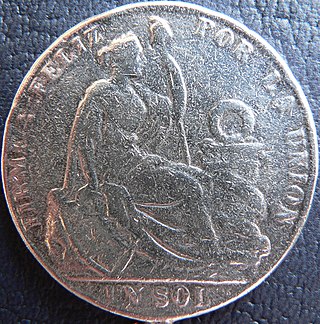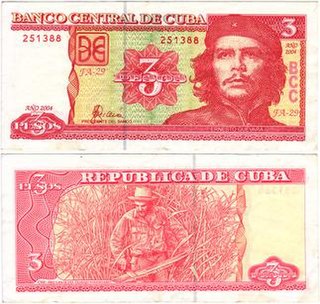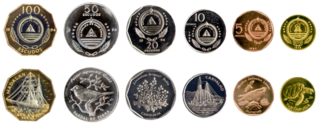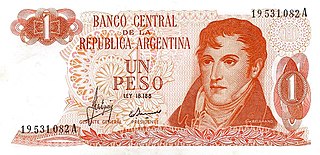The Mexican peso is the official currency of Mexico. The peso was first introduced in 1863, replacing the old Spanish colonial real. The Mexican peso is subdivided into 100 centavos, represented by "¢". Mexican banknotes are issued by the Bank of Mexico in various denominations and feature vibrant colors and imagery representing Mexican culture and history. Modern peso and dollar currencies have a common origin in the 16th–19th century Spanish dollar, most continuing to use its sign, "$".
The peso is the currency of Chile. The current peso has circulated since 1975, with a previous version circulating between 1817 and 1960. Its symbol is defined as a letter S with either one or two vertical bars superimposed prefixing the amount, $ or ; the single-bar symbol, available in most modern text systems, is almost always used. Both of these symbols are used by many currencies, most notably the United States dollar, and may be ambiguous without clarification, such as CLP$ or US$. The ISO 4217 code for the present peso is CLP. It was divided into 100 centavos until 31 May 1996, when the subdivision was formally eliminated. In July 2024, the exchange rate was around CLP940 to US$1.

The Philippine peso, also referred to by its Filipino name piso, is the official currency of the Philippines. It is subdivided into 100 sentimo, also called centavos.
The peso is the currency of Argentina since 1992, identified within Argentina by the symbol $ preceding the amount in the same way as many countries using peso or dollar currencies. It is subdivided into 100 centavos, but due to rapid inflation, coins and notes with a value lower than 500 pesos are now rarely used. Its ISO 4217 code is ARS. It replaced the austral at a rate of 10,000 australes to one peso.

The córdoba is the currency of Nicaragua and is divided into 100 centavos.

The Sucre was the currency of Ecuador between 1884 and 2000. Its ISO code was ECS and it was subdivided into 10 decimos and 100 centavos. The sucre was named after Latin American political leader Antonio José de Sucre. The currency was replaced by the United States dollar as a result of the 1998–99 financial crisis.

The sol, later sol de oro, was the currency of Peru between 1863 and 1985. It had the ISO 4217 currency code PES. It was subdivided into 10 dineros or 100 centavos. It also had two different superunits over its circulation life, the inca (1881–1882) and later the gold pound, both worth 10 soles.

The Colombian peso is the currency of Colombia. Its ISO 4217 code is COP. The official peso symbol is $, with Col$. also being used to distinguish it from other peso- and dollar-denominated currencies.

The Cuban peso also known as moneda nacional, is the official currency of Cuba.

The Dominican peso, officially the peso dominicano since 2010, is the currency of the Dominican Republic. Its symbol is "$", with "RD$" used when distinction from other pesos is required; its ISO 4217 code is "DOP". Each peso is divided into 100 centavos ("cents"), for which the ¢ symbol is used. With exception of the United States dollar, it is the only currency that is legal tender in the Dominican Republic for all monetary transactions, whether public or private.

The peso boliviano was the currency of Bolivia from January 1, 1963, until December 31, 1986. It was replaced by the boliviano. It was divided into 100 centavos. The conversion rate was 1,000,000 pesos bolivianos to 1 boliviano. "$b." was the currency symbol for the peso boliviano.

The escudo is the currency of the Republic of Cape Verde. One escudo is subdivided into one hundred centavos.
The austral was the currency of Argentina between 15 June 1985, and 31 December 1991. It was divided into 100 centavos. The symbol was an uppercase A with an extra horizontal line, (₳). This symbol appeared on all coins issued in this currency, to distinguish them from earlier currencies.
The peso was the currency of Paraguay between 1856 and 1944. It replaced the real at a rate of 8 reales = 1 peso. Until 1870, the peso was subdivided into 8 reales. Paraguay then decimalized, with 100 centésimos = 1 peso. The name of the subdivision was changed to centavo in 1874. The peso was replaced in 1944 by the guaraní at a rate of one hundred to one.
The peso was the currency of El Salvador between 1877 and 1919.

The peso ley 18.188, usually known as either peso or, to distinguish it from the earlier peso moneda nacional, informally as peso ley, was the currency of Argentina between January 1, 1970, and May 5, 1983. It was subdivided into 100 centavos. Its symbol was $L, sometimes $. Its name comes from law 18188 which established it, effective April 5, 1969.
The peso moneda nacional, or simply peso, was the currency of Argentina from 5 November 1881 to 1 January 1970, the date in which the peso ley 18.188 was issued to the Argentine public. It was subdivided into 100 centavos, with the argentino worth 5 pesos. The peso was introduced to replace the Argentine peso moneda corriente at a rate of $+m⁄c 25 = m$n 1.

This is an outline of Uruguay's monetary history. For the present currency of Uruguay, see Uruguayan peso.

The first boliviano was the currency of Bolivia from 1864 to 1963. Due to rising inflation, it was replaced with the peso boliviano at an exchange rate of 1000 bolivianos to 1 peso. The peso was later replaced by the second Bolivian boliviano.
The Chilean peso was the legal tender of Chile from 1817 until 1960, when it was replaced by the escudo, a currency that was itself replaced in 1975 by a new peso.













